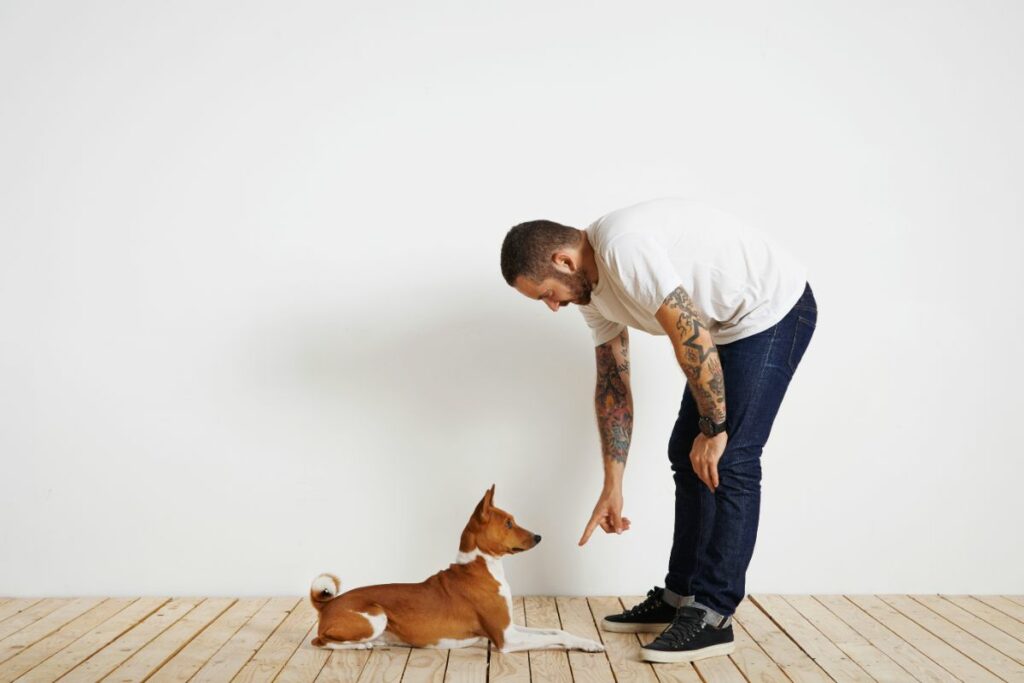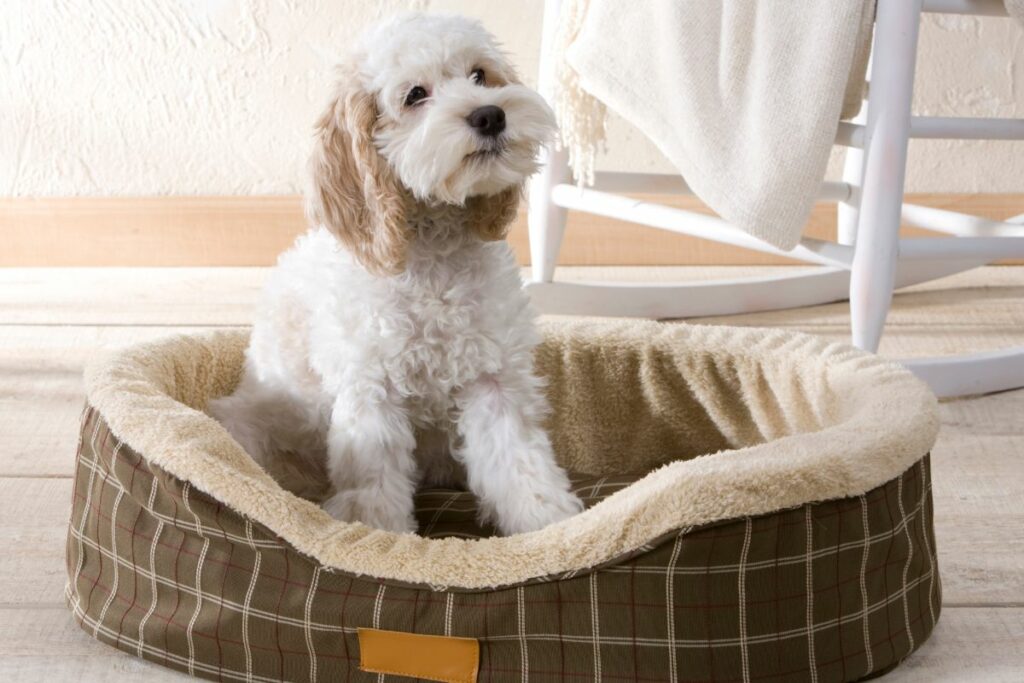If you have a new puppy in your home, you probably know how important it is to ensure that they get the right training at a young age.
Instilling positive behaviors that you want to see whilst your dog is still young will ensure that they grow up well-behaved and well-trained.

With this in mind, what commands should you be teaching your puppy in the first few weeks of it being home?
Well, we highly recommend making sure that they know to sit/lie down, as well as beginning to work on their recall.
This means the dog is being trained to return to you and stay with you at a certain command.
Recall is super important if you’re going to let your dog off-leash on walks.
Another very important command you should introduce to your puppy early on is the Place command.
Let’s learn a little more about this particular command below.
What Is The “Place” Command?
Generally, when we talk about the place command, what we are referring to is a command that tells your puppy that they need to go to a designated place and stay there calmly until they’re released.
You might notice that this command is actually like three different commands in one, which is why it can be pretty difficult to teach.
However, you’ll also be able to work out how massively important it’s going to be to get your puppy used to the command.
With the Place command, you will be able to encourage your dog to be calm in otherwise stressful situations.
For example, when you have guests coming round or people knocking at the door.
Often, these situations can trigger a lot of stress in your dogs, so having a designated calm area will help defuse the anxiety in your puppy much quicker.
The best way to work towards your puppy’s understanding of the Place command is to work through different routines and patterns that are designed to be fun and engaging for your puppy.
That way, your dog is getting in some playtime while learning!
The Plan
If you’re going to start teaching your puppy the Place command successfully, then the first thing that you’ll need to do is to introduce them to a routine where they go between two different targets. This could be a dog bed and a crate.
This will start to get the idea of different places in their head so that it’s not as confusing.
In between going to the target areas, you’ll want to utilize the Come command, so they’re also getting some good practice of their recall skills whilst learning this new command.
Every time your puppy responds correctly to your command, make sure you’re rewarding them with their favorite treat so that they associate doing the right thing with getting a reward.
Over time, as your puppy can get to their Place correctly, you can start to incorporate more commands into the routine. This could be Sit or Down. Eventually, you’ll start to see the routine fall into place.
How To Start
When you’re ready to begin, sit a stand close enough to their bed/cot/crate/wherever you want their place to be so that you can use food lures to get them into that place.
Get your puppy to Come to you first, then use a lure to get them onto their target and say Place (or whatever you want your command word to be.
It can be any word that works for you; just make sure you’re consistent with it, or it can be confusing).
Reward them for being at their place on the command, and then call them back away from their place.
Repeat this process a few times until you’re sure that your puppy understands where their place is – we suggest moving yourself to different areas or further away from their target as they grow more confident in order to introduce them to the idea that they could need to find their place from anywhere in the house.
The Next Step
Once they’re confident with Place, you can start to introduce Sit or Down into the routine, at first rewarding every time they follow through with the entire routine.
However, you’ll want to start rewarding them with less food so that they’re not as reliant on the reward in order to complete the routine.
As they start to get more comfortable with their Place command, you can start to introduce different “places” to them, ensuring that you use a different word to signal that you want them to go to a different target.
For example, you could have Place to signal to the dog that they need to go to their cot or crate and Bed to tell them to go to their dog bed.
We recommend teaching both places at the same time and swapping between the targets, as well as how fast you call the commands to keep your puppy engaged for longer!
Puppy Tip: Ensure that you have enough treats to get through the session and have an idea of how long you’d like the training session to go on for.
Puppies don’t always have the best attention spans, and trying to force them to continue training after they’ve lost interest can result in some negative associations or unnecessary stress.
Just be sure that you pay attention to your puppy’s cues so that you know when you need to start wrapping things up.
Advanced Mode
It could take multiple sessions over several weeks before you feel like your puppy has a solid grasp on the Place command, or they could get it much quicker.
However, once you think they’ve got it, you can start to add real-world distractions to further their confidence.
Distraction
You can practice adding distractions to your routine by having the TV on or having lots of people talking. We highly recommend practicing this command whilst playing recordings of someone knocking at your door or pressing the doorbell.
Very often, you will use the place command to calm your dog when you have guests, so getting them used to returning to their place upon hearing these sounds is great practice.
Duration And Distance
Another important factor that you want to introduce your puppy to is how long they might need to stay in their place.
For this advancement, you’ll want to ensure that your puppy knows the Stay command, as it will be very important to your success.
Once your puppy is in its place and sits calmly, you can introduce Stay as part of the routine. Take a few steps back and wait before you call for your dog to Come again and reward them for waiting.
Increase the amount of time you take and how far you move away to get your puppy used to the idea that you might need to command them to their place and then be occupied with something else for a little while.
If you can get your puppy to understand that they can’t leave their place until they’ve been released, then you’re going to find that the place command will be a lot more convenient for you.

Why Is The Place Command Important?
As we mentioned, Place is an important command not just because it will make potentially triggering situations like having guests over much less stressful but also because it teaches or otherwise reinforces a lot of other wanted behaviors.
For example, you’re continuing to teach your puppy to generally listen and respond to your commands, which is always going to be an important aspect of owning a puppy. But you’re also reinforcing commands like Come, Sit, and Stay, all of which will be used daily.
Many dogs, particularly working breeds, want to be learning and feel like they’re working, and strong practice routines and patterns are a great way to engage them physically and mentally, meaning that they’re less likely to act out.
However, if they do act out every so often, you have a more solid foundation for discouraging the behavior if you’ve already started this training.
Other Things You Can Try
If your puppy responds well to the Place command but ends up barking or not calming the way you’d like them to, then there are still a few other things that you can try in order to help them settle more easily.
A popular solution is teaching your dog to get a toy or pillow when they’re stressed or when they hear certain triggering sounds like the doorbell or someone knocking.
They can’t really bark with something in their mouth, and this redirection might just distract them enough to feel calmer just because they have something else to focus on.
Combining this with the Place command should result in a calm and happy dog in situations that would be otherwise pretty stressful.
Top Tips For Teaching The Place Command
Here are just a few tips that you should bear in mind when you’re training your puppy, regardless of which command you’re trying to teach.
Don’t Punish Unwanted Behavior
This one sounds counter-productive, but many animal behavior specialists agree that most animals don’t learn anything from being punished except to be fearful or have negative associations with their owners.
Reward Wanted Behavior
Instead of punishing them, you want to redirect them into a wanted behavior.
For example, if your dog is barking and growling, you need to work with their anxieties to support them and reward the behavior that you do want to see.
Go At Your Puppy’s Pace
Pay attention and watch for your puppy’s cues to tell you when they’re bored or overstimulated from the training.
The last thing that you want to happen is for them to have negative associations with you or with the idea of training.
A dog that feels stressed out when it’s learning new things will struggle far more than a puppy who just thinks that the training is a game.
Patience, Praise, Practice
These three P’s are going to be the most important words to keep in mind when you’re training your puppy.
Just like any other child, your puppy is going to want to play, and it’s going to want to be a little mischievous. Lean into these behaviors to better work with your puppy in order to train it at its own pace.
You need to have patience in order to keep calm whilst training your puppy. You need to make sure you are consistently praising and rewarding good and wanted behaviors, and you need to ensure that you keep practicing.
You should be going over these commands with your puppy at least once a day if you want to see great success.
In Summary
The Place command can be helpful for teaching your dog to go somewhere specific to wait calmly.
We recommend starting this type of training with your puppy from a young age.
- A Simple Guide On Teaching Your Puppy The Place Command - August 23, 2023
- A Pawprint Pets Guide To Puppy Breeds: Siberian Husky - August 14, 2023
- A Pawprint Pets Guide To Puppy Breeds – Golden Retrievers - August 10, 2023
